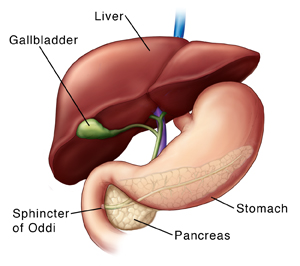Sphincter of Oddi Dysfunction
The sphincter of Oddi is part of your digestive system. A sphincter is a circle of muscle. The sphincter of Oddi surrounds the end of the tubes (ducts) that connect the gallbladder, liver, and pancreas to the first part of the small intestine (duodenum). The sphincter opens to let digestive juices flow through the ducts from the gallbladder, liver, and pancreas into the small intestine. To prevent the juices from leaking back into the ducts, the sphincter squeezes shut.
In some people, the sphincter squeezes shut (spasms) when it shouldn’t. In others, the sphincter is too narrow (stenosis) or there are stones in the bile duct. This is called sphincter of Oddi dysfunction (SOD). When this happens, the juices can’t flow out of the gallbladder, liver, and pancreas. The spasms cause pain in the abdomen. The backup of juices can cause the liver and pancreas to become swollen and painful.
Healthcare providers aren’t sure why SOD happens. It almost always happens in people who have had their gallbladders taken out.

Symptoms of sphincter of Oddi dysfunction
The main symptom of SOD is severe abdominal pain that comes and goes. It can sometimes happen after eating. It may last for up to several hours. The pain may feel like a gallbladder attack. The pain may be in your upper abdomen and seem to spread into your right shoulder. You may also have nausea and vomiting. It can also cause recurrent pancreatitis.
How is sphincter of Oddi dysfunction diagnosed?
SOD can be difficult to diagnose. If your healthcare provider thinks you may have sphincter of Oddi dysfunction, you may have certain tests to see if you may have SOD or another condition. You may have blood tests. These check for enzymes that can show problems with the liver and the pancreas.
You may also have some imaging tests. These let the healthcare provider get a closer look at the gallbladder, liver, pancreas, and the ducts connecting them. You may have one or more of these tests:
-
Ultrasound. This uses harmless sound waves and a computer to create images of internal organs.
-
EUS. This is an internal ultrasound also using sound waves.
-
X-rays. These use radiation to create images of organs.
-
CT scan. This uses a series of X-rays to create a 3-D picture.
-
MRI. This test uses magnets to create an image of the inside of the body.
-
Upper endoscopy. This uses a thin tube connected to a camera. It can show images inside the digestive tract. It may be done to see if your symptoms are from an ulcer or reflux.
-
MRCP. This test uses magnets and a special dye to create images of the bile and pancreatic ducts.
-
ERCP. This test looks more closely at the ducts and sphincter. During the test, a flexible, lighted tube with a camera on the end is used. This is called an endoscope (scope). The scope is swallowed into the stomach. Images of inside the digestive tract are sent from the scope to a video screen. Using these images, the scope is moved into the small intestine to the sphincter of Oddi. A small tube is put through the scope. Dye is injected through the tube. This makes the ducts and sphincter show up clearly on X-rays. X-rays are then taken. In some cases, air is sent through the tube. The air tests the pressure of the sphincter muscle. This is called manometry.
Treating sphincter of Oddi dysfunction
SOD can also be difficult to treat. You will probably be referred to a healthcare provider who specializes in treating SOD. Treatment of SOD depends on your test results and how severe your symptoms are. If you have symptoms of SOD but your tests don't show SOD, you may be given medicine. Medicine can include pain relievers, muscle relaxants, antispasmodics, or antidepressants. These may help relax the sphincter and relieve symptoms.
Another treatment is called sphincterotomy. It may be done in some cases if symptoms are severe, happen often, and cause serious problems. During a sphincterotomy, the surgeon cuts the sphincter of Oddi with a tiny blade or thin wire. This is done during an ERCP. This can prevent spasms.
Risks and possible complications
Invasive diagnosis or treatment of SOD may cause certain problems. ERCP and sphincterotomy can sometimes cause inflammation of the pancreas. Other risks include bleeding, infection, scarring of the ducts, and, very rarely, death. Talk with your healthcare provider about the risks and benefits of these procedures.
Living with sphincter of Oddi dysfunction
If you have been diagnosed with SOD or you are recovering from a sphincterotomy, follow all your healthcare provider's orders. Take all of your medicines as directed. Make sure your healthcare provider knows about any other medicines you take, including over-the-counter medicines, supplements, and herbs.
When to call your healthcare provider
After treatment, call your healthcare provider right away if:
-
Your symptoms get worse
-
You have signs of jaundice, such as yellowing of your skin or the whites of your eyes
-
You develop a fever of 100.4°F (38°C) or higher, or as advised by your healthcare provider
-
Chills